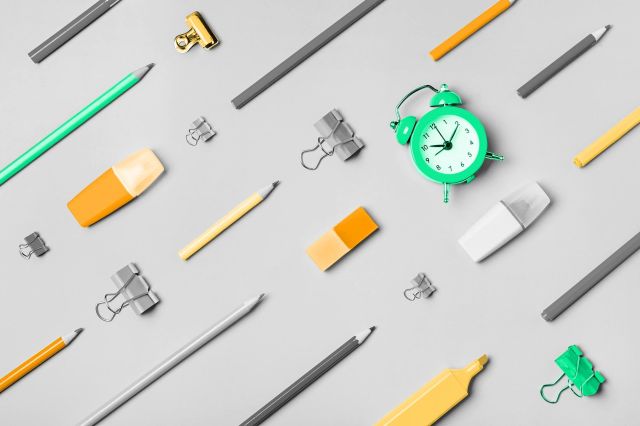
Henry David Thoreau Helped Create the No. 2 Pencil
This bright-yellow tool might never have existed if not for a stroke of luck. According to legend, its creation stems from a discovery made in England in 1564. During a storm, a large deposit of graphite (the “lead” now inside pencils) was unearthed clinging to the roots of a fallen tree, and locals realized that the material could make dark-gray sketch marks on paper. By the following year, Swiss naturalist Conrad Gessner had sketched the first known depiction of a wooden pencil (a plug of graphite in a wooden tube), and by 1662, a similar product was being mass-produced in Nuremberg, Germany.
A 1795 innovation led to a modern makeover for the pencil, when French chemist Nicolas-Jacques Conté developed a new technique for producing the actual material used to write. With supplies of high-quality plumbago (then a term for English graphite) cut off due to war between Revolutionary France and Britain, Conté combined a mixture of clay and lower-quality graphite — and found it so successful that a similar formula is still used in pencils today. These “Conté crayons” not only served as a solution to the graphite shortage, but led to further experimentation within the world of pencils.
Another surprising development in the history of the pencil took place in the United States in the 1840s. While working at his father’s pencil factory, transcendentalist writer and philosopher Henry David Thoreau — best known as the author of Walden, a landmark series of essays on self-reliance — helped conceive of a new numbering system to describe the lightness and darkness, as well as the hardness and softness, of a pencil’s graphite. Labeled from numbers one to four, this new notation system took off nationwide, and the now-beloved No. 2 pencil became most popular due to the perfect balance of those qualities.

Bread Was Used as an Eraser Before Rubber
What was the classroom like before the modern eraser? Prior to the 1770s, balled-up wads of moist bread were used to correct written mistakes. Fortunately for those who would rather eat bread than use it as a tool, that method was rendered obsolete long before modern schooling began. In 1770, scientist Joseph Priestly (the same man who discovered oxygen) noticed the erasing properties of a substance he initially called “India gum,” but which he later called “rubber” due to the rubbing action required by the user. The same year, British engineer Edward Nairne also stumbled upon rubber’s erasing abilities — allegedly when he accidentally reached for some rubber instead of breadcrumbs. Nairne went on to develop and market the first popular, practical erasers in Europe.
In 1839, erasers became more commonplace after chemist and engineer Charles Goodyear discovered a method for curing natural rubber to prevent rotting. He called this “vulcanization” — named after the Roman god of fire — and patented the process in 1844. A Philadelphia stationer named Hymen Lipman took the development of erasers one step further in 1858 by attaching one to the end of a pencil, forever simplifying the ability to correct one’s mistakes.

Protractors Were Commonly Used for Navigation
While many of us probably haven’t picked up a protractor since high school math class, the instrument used to measure angles served an important role in the field of navigation for at least 500 years. Or perhaps even longer: An early precursor to modern protractors was discovered in the tomb of an Egyptian architect named Kha, dating back to around 1400 BCE. In the 1589 work Briefe Description of Universal Mappes & Cardes, Thomas Blundeville described a protractor-like tool used to prepare maps and navigational charts, and by the 1600s, the tool was commonly used by sailors at sea.
In 1801, U.S. naval captain Joseph Huddart designed a more sophisticated protractor meant for plotting the direction of a ship. Protractors were also used for coastal surveying projects, and in the 20th century, they found their place in the sky as an instrument for aviation navigation — as well as, of course, head-scratching problems in math class.
More Interesting Reads

Glue Sticks Were Inspired by Lipstick Applicators
Kindergarten teachers around the world are no strangers to messy, glue-covered hands, but thanks to the German company Henkel, craft time became a whole lot cleaner with the advent of the glue stick. Henkel’s invention of the Pritt brand glue stick in 1969 featured a design inspired by twist-up lipstick applicators. Adhesives researcher Dr. Wolfgang Dierichs first proposed the design in 1967 after witnessing a woman applying lipstick during a flight. Dierichs was amazed at how careful the lipstick application process was and determined the method could also be applied to glue. Though the company struggled to thicken the glue at first, the solution proved to be a mixture of soap gel and water-soluble adhesive. In 1971, two years after the creation of the glue stick, Carl Weller filed a patent for the first glue gun — though that product should probably remain out of the hands of school children.

Scotch Tape Was Used to Paint Cars and Repair Blimps
Long before tape became a mainstay of arts and crafts classrooms, it was developed for a different artistic purpose. Working for the Minnesota Mining and Manufacturing Company (later known as 3M), inventor Richard Drew created the first masking tape in 1925 to facilitate painting two-tone automobiles, a popular design trend at the time. The tape would help cover up one part of the car while the other part was painted. However, the painters found the initial design subpar, since it had adhesive only at the edges, and angrily told Drew to take his “Scotch” tape back — at the time, “Scotch” unfortunately often meant “cheap.”
Drew went back to the drawing board, and in 1930, he successfully produced the first roll of a new cellophane tape, which received rave reviews. This transparent tape became so popular that it was used as an anti-corrosive layer on Goodyear blimps, and in 1946, the tape was even used to help repair the rudder of an airplane that had been damaged by cows. While that may not sound reassuring for travelers, it goes to show how versatile the product was before it became an everyday household and classroom tool for art projects, gift-wrapping, and more.

Post-it Notes Were Used as Bookmarks in Church Hymn Books
The company 3M brought us not only Scotch tape, but also Post-it Notes. In 1968, Spencer Silver, a chemist at the company, started working on an adhesive that was sticky enough to attach to surfaces but could peel apart without leaving damage. He struggled to find a practical application for the product, but in 1974, his colleague Art Fry approached him seeking assistance with a problem he kept encountering during church. Fry had been bookmarking his hymn book with regular pieces of paper during choir practice and found that they kept falling out. Fry was delighted that the Post-its could be used without damaging the pages, and he even started using them around the office to convey messages.
Though Silver and Fry saw the immediate benefit of Post-it Notes, it was a challenge to convince the larger public of their usefulness. It wasn’t until a 1978 marketing campaign known as the Boise Blitz — which distributed free samples to offices in the Idaho city — that the Post-it Note achieved more widespread popularity. A reported 90% of recipients in the marketing campaign said they would buy the product again, and the rest is history.

Index Cards Were Invented by the Founder of Modern Taxonomy
Swedish botanist Carl Linnaeus is considered the father of modern taxonomy — scientific classification schemes — but he’s also responsible for the invention of a helpful item now used at school for memorization and more. In the 1760s, Linnaeus was searching for a way to organize what he found to be an overwhelming amount of research and information that was being discovered in other countries around the world. The result of his quest? The simple yet sturdy index card. Linnaeus found these small pieces of paper, which he cut down by hand, easier to organize and retrieve than regular paper, and used them frequently. Today, a set of over 1,000 paper slips used by Linnaeus can be viewed at the Linnaean Society in London. Though slightly flimsier, these historic relics are largely indistinguishable from modern index cards.












